NGR1 reduces neuronal apoptosis through regulation of ITGA11 following subarachnoid hemorrhage
- Authors:
- Yu Hou
- Lihan Zhang
- Wenzhe Ma
- Yong Jiang
-
Affiliations: State Key Laboratory of Quality Research in Chinese Medicine, Macau University of Science and Technology, Macau, SAR 999078, P.R. China, Laboratory of Neurological Diseases and Brain Function, The Affiliated Hospital of Southwest Medical University, Luzhou, Sichuan 646000, P.R. China, State Key Laboratory of Quality Research in Chinese Medicine, Macau University of Science and Technology, Macau, SAR 999078, P.R. China - Published online on: January 8, 2025 https://doi.org/10.3892/mmr.2025.13432
- Article Number: 67
-
Copyright: © Hou et al. This is an open access article distributed under the terms of Creative Commons Attribution License.
This article is mentioned in:
Abstract
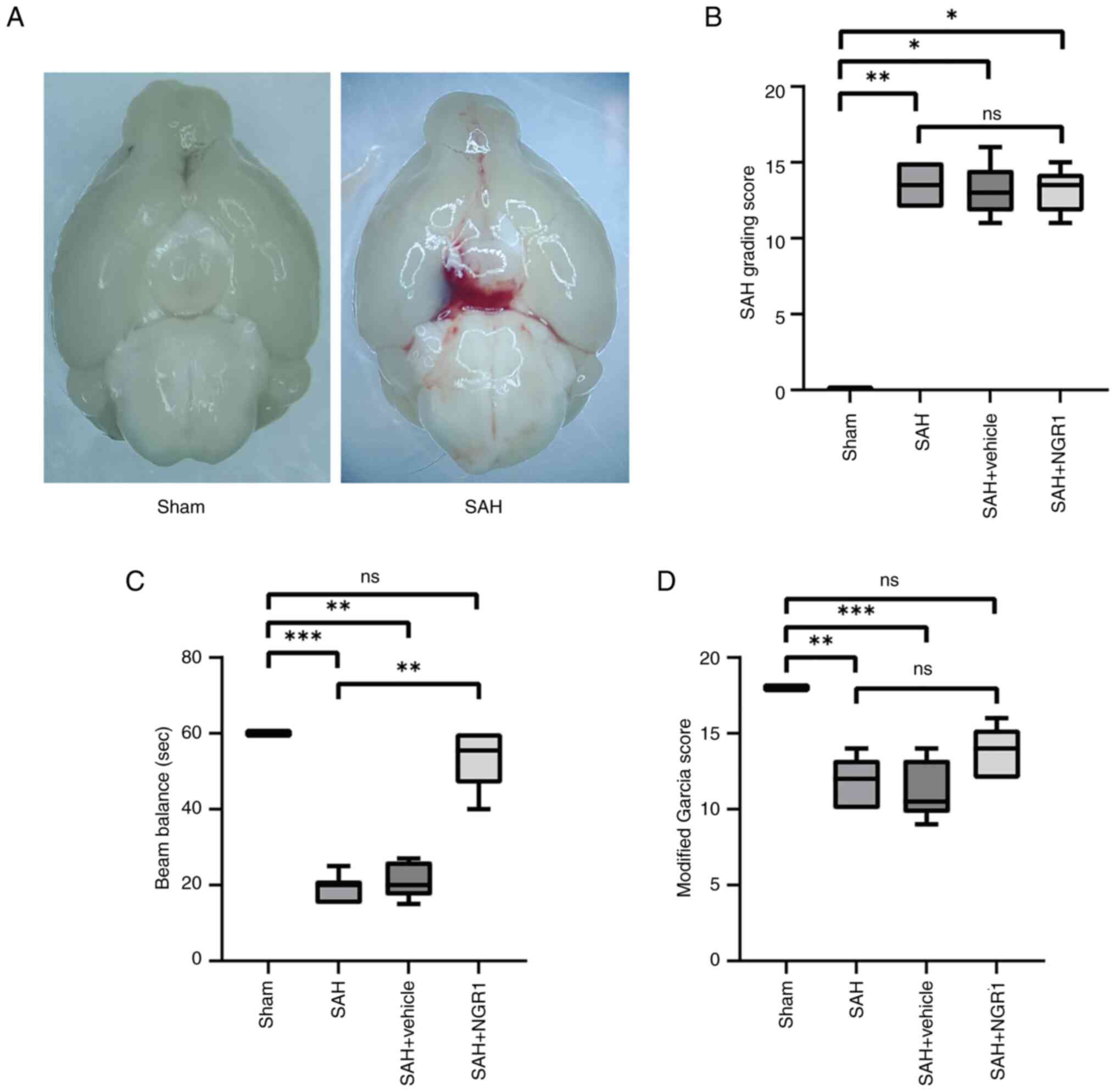 |
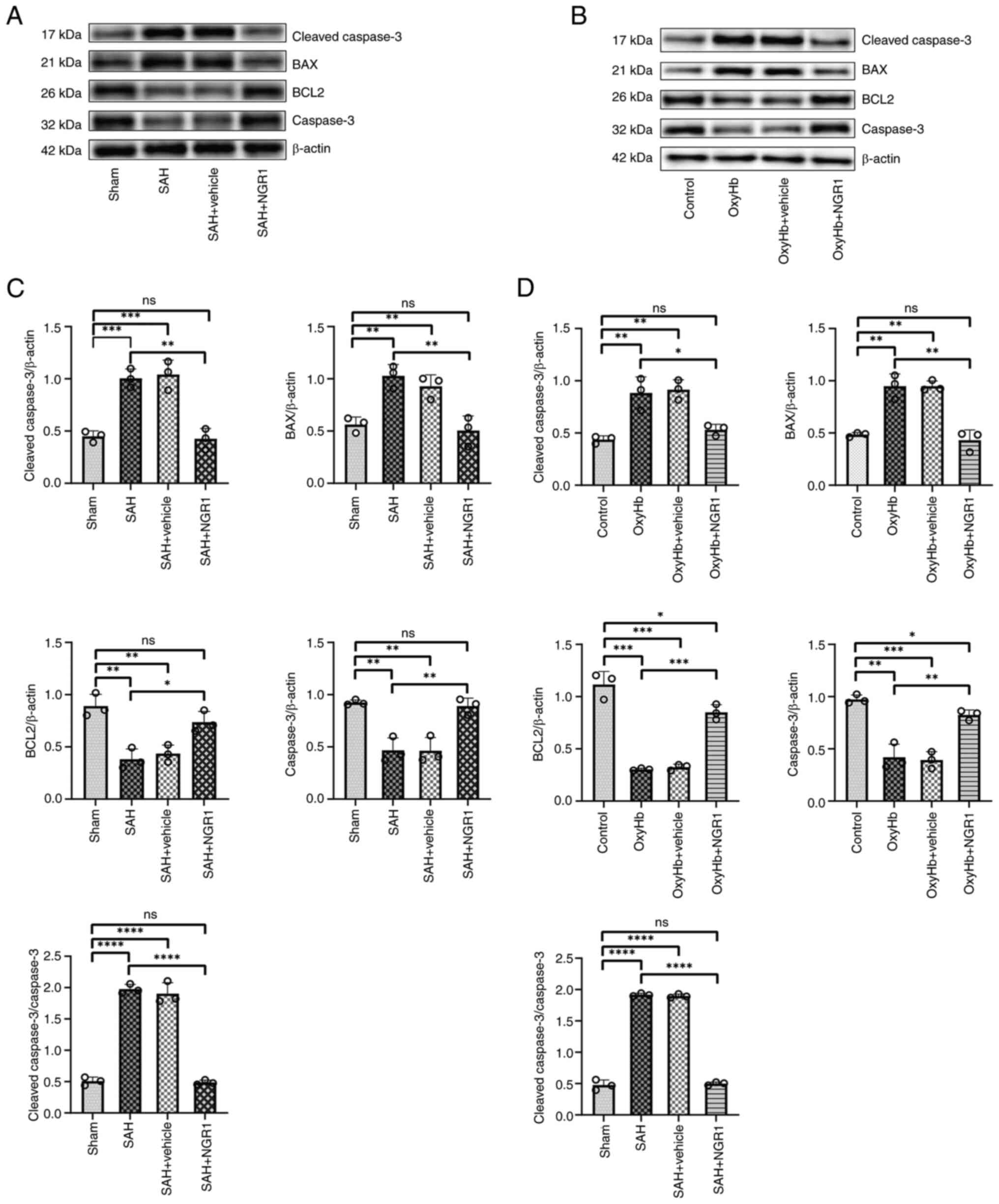 |
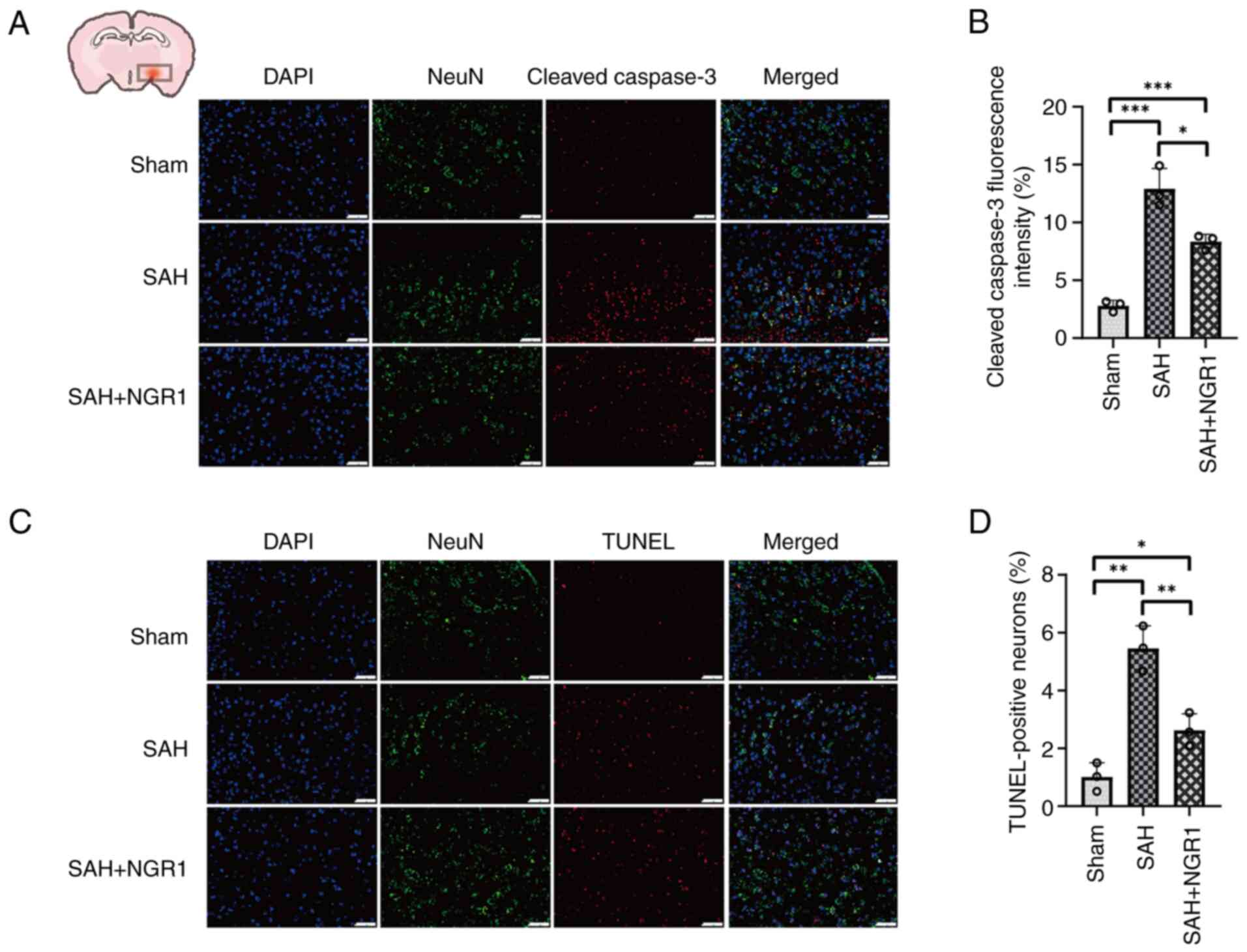 |
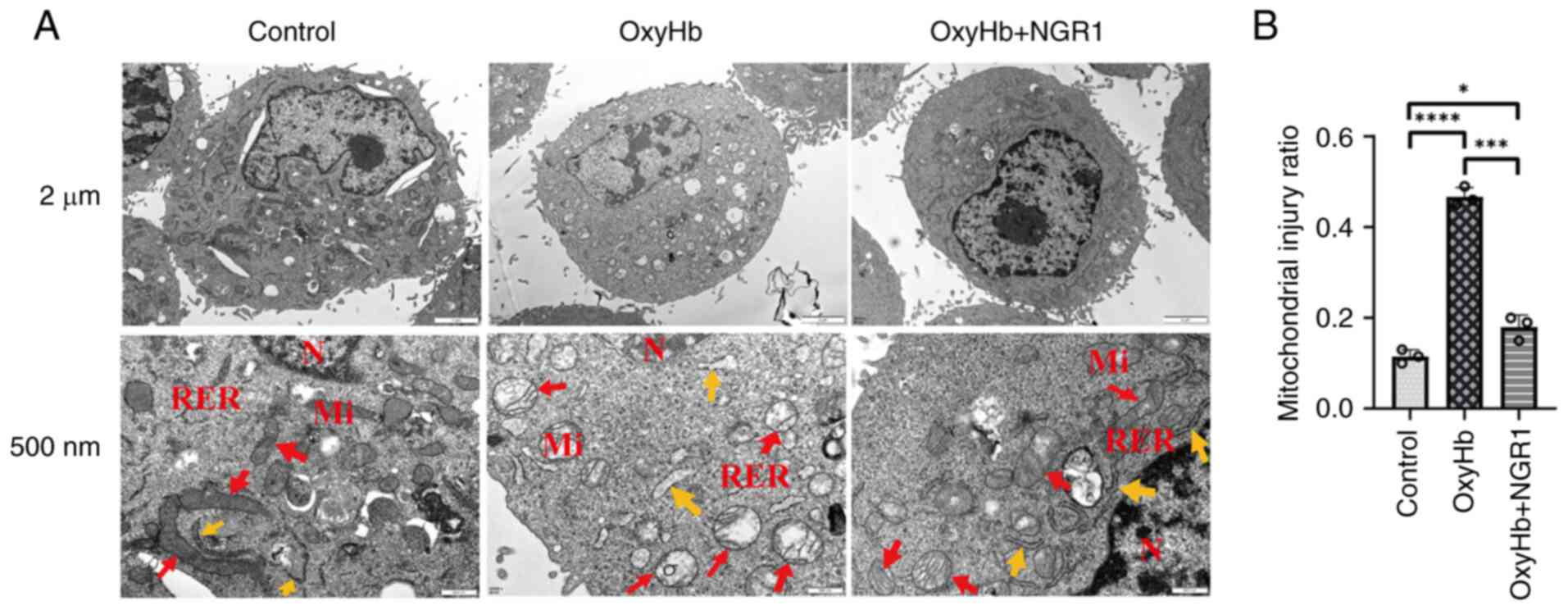 |
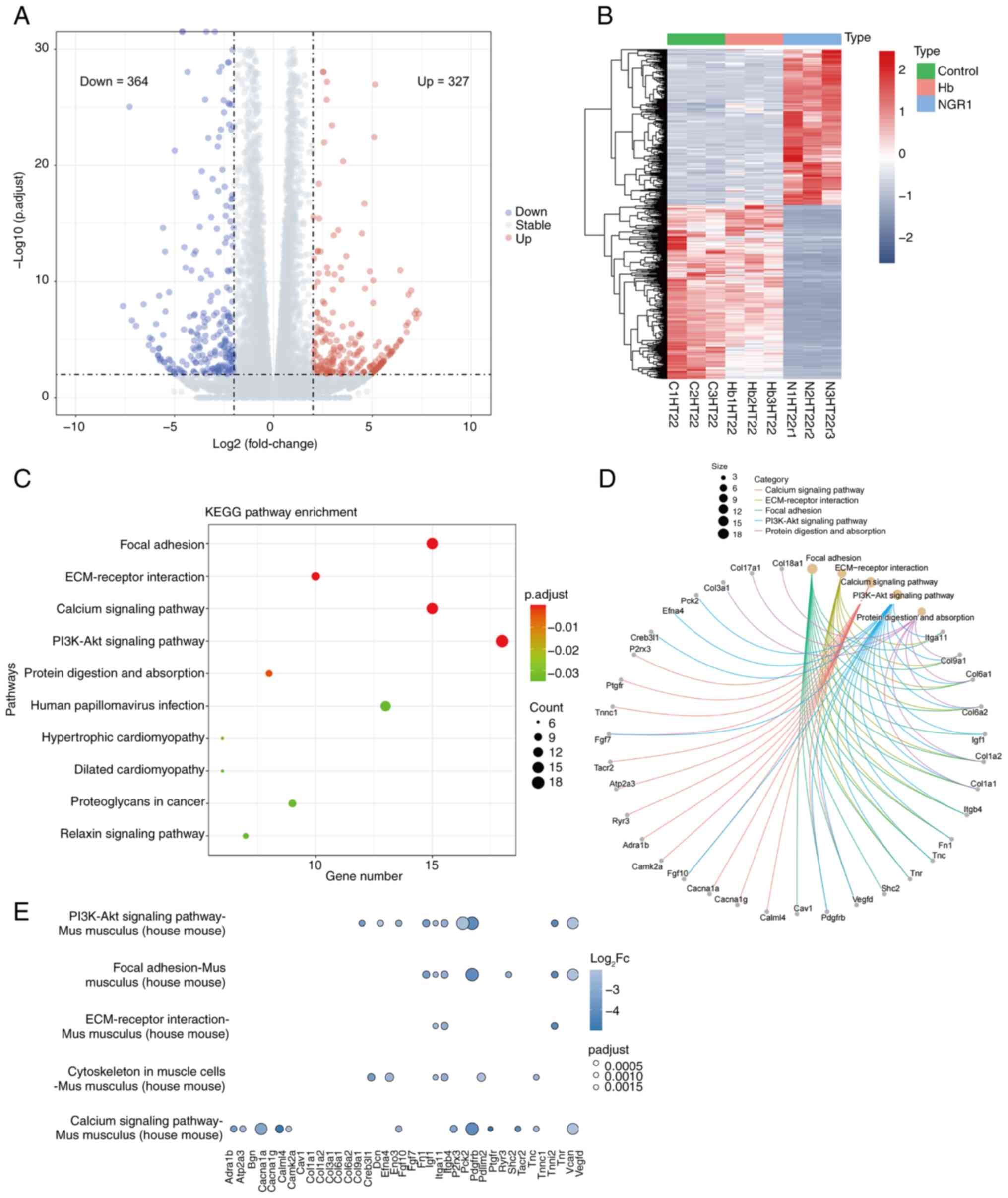 |
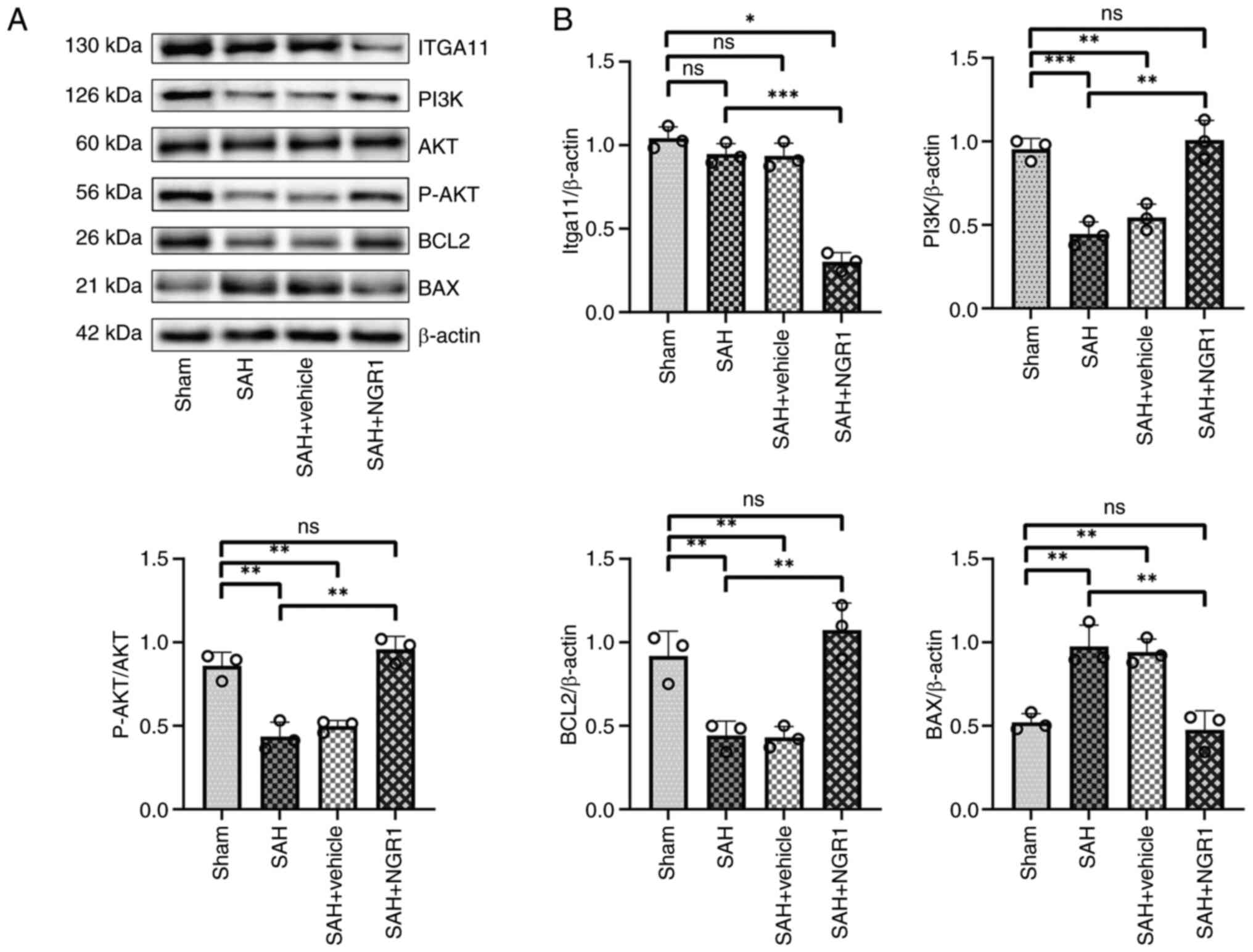 |
|
Thilak S, Brown P, Whitehouse T, Gautam N, Lawrence E, Ahmed Z and Veenith T: Diagnosis and management of subarachnoid haemorrhage. Nat Commun. 15:18502024. View Article : Google Scholar : PubMed/NCBI | |
|
Peng L, Qin H, Liu J, Wu N, Wang X, Han L and Ding X: Neurosurgical clipping versus endovascular coiling for patients with ruptured anterior circulation aneurysms: A systematic review and meta-analysis. Neurosurg Rev. 47:682024. View Article : Google Scholar : PubMed/NCBI | |
|
Chalet FX, Briasoulis O, Manalastas EJ, Talbot DA, Thompson JC and Macdonald RL: Clinical burden of angiographic vasospasm and its complications after aneurysmal subarachnoid hemorrhage: A systematic review. Neurol Ther. 12:371–390. 2023. View Article : Google Scholar : PubMed/NCBI | |
|
Cahill J and Zhang JH: Subarachnoid hemorrhage: Is it time for a new direction? Stroke. 40 (3 Suppl):S86–S87. 2009. View Article : Google Scholar : PubMed/NCBI | |
|
Schupper AJ, Hardigan TA, Mehta A, Yim B, Yaeger KA, De Leacy R, Fifi JT, Mocco J and Majidi S: Sex and racial disparity in outcome of aneurysmal subarachnoid hemorrhage in the United States: A 20-year analysis. Stroke. 54:1347–1356. 2023. View Article : Google Scholar : PubMed/NCBI | |
|
Lauzier DC, Jayaraman K, Yuan JY, Diwan D, Vellimana AK, Osbun JW, Chatterjee AR, Athiraman U, Dhar R and Zipfel GJ: Early brain injury after subarachnoid hemorrhage: Incidence and mechanisms. Stroke. 54:1426–1440. 2023. View Article : Google Scholar : PubMed/NCBI | |
|
Huang H and Lai LT: Incidence and case-fatality of aneurysmal subarachnoid hemorrhage in Australia, 2008–2018. World Neurosurg. 144:e438–e446. 2020. View Article : Google Scholar : PubMed/NCBI | |
|
Xia C, Hoffman H, Anikpezie N, Philip K, Wee C, Choudhry R, Albright KC, Masoud H, Beutler T, Schmidt E, et al: Trends in the incidence of spontaneous subarachnoid hemorrhages in the United States, 2007–2017. Neurology. 100:e123–e132. 2023. View Article : Google Scholar : PubMed/NCBI | |
|
Qureshi AI, Bhatti IA, Gillani SA, Beall J, Cassarly CN, Gajewski B, Martin RH, Suarez JI and Kwok CS: Prevalence, trends, and outcomes of cerebral infarction in patients with aneurysmal subarachnoid hemorrhage in the USA. J Neuroimaging. 34:790–798. 2024. View Article : Google Scholar : PubMed/NCBI | |
|
Vasconcellos de Oliveira Souza N, Rouanet C, Fontoura Solla DJ, Barroso de Lima CV, Trevizo J, Rezende F, Alves MM, de Oliveira Manuel AL, Righy C, Chaddad Neto F, et al: Impact of medical and neurologic complications on the outcome of patients with aneurysmal subarachnoid hemorrhage in a middle-income country. World Neurosurg. 183:e250–e260. 2024. View Article : Google Scholar : PubMed/NCBI | |
|
Zhu W, Ling X, Petersen JD, Liu J, Xiao A and Huang J: Clipping versus coiling for aneurysmal subarachnoid hemorrhage: A systematic review and meta-analysis of prospective studies. Neurosurg Rev. 45:1291–1302. 2022. View Article : Google Scholar : PubMed/NCBI | |
|
de Liyis BG, Surya SC and Tini K: Effectivity and safety of endovascular coiling versus microsurgical clipping for aneurysmal subarachnoid hemorrhage: A systematic review and meta-analysis. Clin Neurol Neurosurg. 236:1080582024. View Article : Google Scholar : PubMed/NCBI | |
|
Le VT, Nguyen AM and Nguyen PL: Risk factors for in-hospital seizure and new-onset epilepsy in coiling and clipping treatment of aneurysmal subarachnoid hemorrhage. World Neurosurg. 184:e460–e467. 2024. View Article : Google Scholar : PubMed/NCBI | |
|
Früh A, Wolf S, Wasilewski D, Vajkoczy P and Truckenmueller P; EARLYDRAIN study group, : Early complications and outcome after treatment of ruptured aneurysms in patients with subarachnoid hemorrhage-A post hoc analysis of the EARLYDRAIN trial. World Neurosurg. 184:e720–e730. 2024. View Article : Google Scholar : PubMed/NCBI | |
|
Li M, Tian Z, Ru X, Shen J, Chen G, Duan Z and Cui J: Comparison of endovascular interventional embolization and microsurgical clipping for ruptured cerebral aneurysms: Impact on patient outcomes. Int J Neurosci. 1–8. 2024. View Article : Google Scholar | |
|
Hoh BL, Topcuoglu MA, Singhal AB, Pryor JC, Rabinov JD, Rordorf GA, Carter BS and Ogilvy CS: Effect of clipping, craniotomy, or intravascular coiling on cerebral vasospasm and patient outcome after aneurysmal subarachnoid hemorrhage. Neurosurgery. 55:779–789. 2004. View Article : Google Scholar : PubMed/NCBI | |
|
Tawakul A, Alluqmani MM, Badawi AS, Alawfi AK, Alharbi EK, Aljohani SA, Mogharbel GH, Alahmadi HA and Khawaji ZY: Risk factors for cerebral vasospasm after subarachnoid hemorrhage: A systematic review of observational studies. Neurocrit Care. 41:1081–1099. 2024. View Article : Google Scholar : PubMed/NCBI | |
|
Lele AV, Fong CT, Walters AM and Souter MJ: External ventricular drain placement, critical care utilization, complications, and clinical outcomes after spontaneous subarachnoid hemorrhage: A single-center retrospective cohort study. J Clin Med. 13:10322024. View Article : Google Scholar : PubMed/NCBI | |
|
Kamp MA, Lieshout JHV, Dibué-Adjei M, Weber JK, Schneider T, Restin T, Fischer I and Steiger HJ: A systematic and meta-analysis of mortality in experimental mouse models analyzing delayed cerebral ischemia after subarachnoid hemorrhage. Transl Stroke Res. 8:206–219. 2017. View Article : Google Scholar : PubMed/NCBI | |
|
Dayyani M, Sadeghirad B, Grotta JC, Zabihyan S, Ahmadvand S, Wang Y, Guyatt GH and Amin-Hanjani S: Prophylactic therapies for morbidity and mortality after aneurysmal subarachnoid hemorrhage: A systematic review and network meta-analysis of randomized trials. Stroke. 53:1993–2005. 2022. View Article : Google Scholar : PubMed/NCBI | |
|
Sun G: Death and survival from executioner caspase activation. Semin Cell Dev Biol. 156:66–73. 2024. View Article : Google Scholar : PubMed/NCBI | |
|
Tan W, Li Y, Ma L, Fu X, Long Q, Yan F, Li W, Liu X, Ding H, Wang Y and Zhang W: Exosomes of endothelial progenitor cells repair injured vascular endothelial cells through the Bcl2/Bax/caspase-3 pathway. Sci Rep. 14:44652024. View Article : Google Scholar : PubMed/NCBI | |
|
Zhu C, Fan F, Li CY, Xiong Y and Liu X: Caspase-3 promotes oncogene-induced malignant transformation via EndoG-dependent Src-STAT3 phosphorylation. Cell Death Dis. 15:4862024. View Article : Google Scholar : PubMed/NCBI | |
|
Hongmei Z: Extrinsic and intrinsic apoptosis signal pathway review. Ntuli T: Apoptosis and Medicine. IntechOpen; London, UK: 2012, View Article : Google Scholar | |
|
Siddiqui WA, Ahad A and Ahsan H: The mystery of BCL2 family: Bcl-2 proteins and apoptosis: An update. Arch Toxicol. 89:289–317. 2015. View Article : Google Scholar : PubMed/NCBI | |
|
Pisani C, Ramella M, Boldorini R, Loi G, Billia M, Boccafoschi F, Volpe A and Krengli M: Apoptotic and predictive factors by bax, caspases 3/9, Bcl-2, p53 and Ki-67 in prostate cancer after 12 Gy single-dose. Sci Rep. 10:70502020. View Article : Google Scholar : PubMed/NCBI | |
|
Qian S, Wei Z, Yang W, Huang J, Yang Y and Wang J: The role of BCL-2 family proteins in regulating apoptosis and cancer therapy. Front Oncol. 12:9853632022. View Article : Google Scholar : PubMed/NCBI | |
|
Miller TM, Moulder KL, Knudson CM, Creedon DJ, Deshmukh M, Korsmeyer SJ and Johnson EM Jr: Bax deletion further orders the cell death pathway in cerebellar granule cells and suggests a caspase-independent pathway to cell death. J Cell Biol. 139:205–217. 1997. View Article : Google Scholar : PubMed/NCBI | |
|
Chen Q, Huang Z, Chen J, Tian X, Zhang R, Liang Q, Liu Z and Cheng Y: Notoginsenoside R1 attenuates ischemic heart failure by modulating MDM2/β arrestin2-mediated β2-adrenergic receptor ubiquitination. Biomed Pharmacother. 177:1170042024. View Article : Google Scholar : PubMed/NCBI | |
|
Zhang S, Chen Q, Jin M, Ren J and Sun X, Zhang Z, Luo Y and Sun X: Notoginsenoside R1 alleviates cerebral ischemia/reperfusion injury by inhibiting the TLR4/MyD88/NF-κB signaling pathway through microbiota-gut-brain axis. Phytomedicine. 128:1555302024. View Article : Google Scholar : PubMed/NCBI | |
|
Zeng M, Zhang R, Yang Q, Guo L, Zhang X, Yu B, Gan J, Yang Z, Li H, Wang Y, et al: Pharmacological therapy to cerebral ischemia-reperfusion injury: Focus on saponins. Biomed Pharmacother. 155:1136962022. View Article : Google Scholar : PubMed/NCBI | |
|
Meng X, Sun G, Ye J, Xu H, Wang H and Sun X: Notoginsenoside R1-mediated neuroprotection involves estrogen receptor-dependent crosstalk between Akt and ERK1/2 pathways: A novel mechanism of Nrf2/ARE signaling activation. Free Radic Res. 48:445–460. 2014. View Article : Google Scholar : PubMed/NCBI | |
|
Jiang N, Dai Q, Su X, Fu J, Feng X and Peng J: Role of PI3K/AKT pathway in cancer: The framework of malignant behavior. Mol Biol Rep. 47:4587–4629. 2020. View Article : Google Scholar : PubMed/NCBI | |
|
Liu R, Chen Y, Liu G, Li C, Song Y, Cao Z, Li W, Hu J, Lu C and Liu Y: PI3K/AKT pathway as a key link modulates the multidrug resistance of cancers. Cell Death Dis. 11:7972020. View Article : Google Scholar : PubMed/NCBI | |
|
Fresno Vara JA, Casado E, de Castro J, Cejas P, Belda-Iniesta C and González-Barón M: PI3K/Akt signalling pathway and cancer. Cancer Treat Rev. 30:193–204. 2004. View Article : Google Scholar : PubMed/NCBI | |
|
Vasan N and Cantley LC: At a crossroads: How to translate the roles of PI3K in oncogenic and metabolic signalling into improvements in cancer therapy. Nat Rev Clin Oncol. 19:471–485. 2022. View Article : Google Scholar : PubMed/NCBI | |
|
Barzegar Behrooz A, Talaie Z, Jusheghani F, Łos MJ, Klonisch T and Ghavami S: Wnt and PI3K/Akt/mTOR survival pathways as therapeutic targets in glioblastoma. Int J Mol Sci. 23:13532022. View Article : Google Scholar : PubMed/NCBI | |
|
He Y, Sun MM, Zhang GG, Yang J, Chen KS, Xu WW and Li B: Targeting PI3K/Akt signal transduction for cancer therapy. Signal Transduct Target Ther. 6:4252021. View Article : Google Scholar : PubMed/NCBI | |
|
Manning BD and Cantley LC: AKT/PKB signaling: Navigating downstream. Cell. 129:1261–1274. 2007. View Article : Google Scholar : PubMed/NCBI | |
|
Peng J, Wu Y, Pang J, Sun X, Chen L, Chen Y, Tang J, Zhang JH and Yong J: Single clip: An improvement of the filament-perforation mouse subarachnoid haemorrhage model. Brain Inj. 33:701–711. 2019. View Article : Google Scholar : PubMed/NCBI | |
|
Leary S, Underwood W, Anthony R, Cartner S, Grandin T, Greenacre C, Gwaltney-Brant S, McCrackin MA, Meyer R, Miller D, et al: AVMA guidelines for the euthanasia of animals: 2020 Edition*. American Veterinary Medical Association 1931; N. Meacham Road Schaumburg IL 60173: 2020 | |
|
Huang T, Xiao Y, Zhang Y, Wang C, Chen X, Li Y, Ge Y and Gao J: miR-223 ameliorates thalamus hemorrhage-induced central poststroke pain via targeting NLRP3 in a mouse model. Exp Ther Med. 23:3532022. View Article : Google Scholar : PubMed/NCBI | |
|
Feng X, Ma W, Zhu J, Jiao W and Wang Y: Dexmedetomidine alleviates early brain injury following traumatic brain injury by inhibiting autophagy and neuroinflammation through the ROS/Nrf2 signaling pathway. Mol Med Rep. 24:6612021. View Article : Google Scholar : PubMed/NCBI | |
|
Peng J, Pang J, Huang L, Enkhjargal B, Zhang T, Mo J, Wu P, Xu W, Zuo Y, Peng J, et al: LRP1 activation attenuates white matter injury by modulating microglial polarization through Shc1/PI3K/Akt pathway after subarachnoid hemorrhage in rats. Redox Biol. 21:1011212019. View Article : Google Scholar : PubMed/NCBI | |
|
Zhang CS, Han Q, Song ZW, Jia HY, Shao TP and Chen YP: Hydrogen gas post-conditioning attenuates early neuronal pyroptosis in a rat model of subarachnoid hemorrhage through the mitoKATP signaling pathway. Exp Ther Med. 22:8362021. View Article : Google Scholar : PubMed/NCBI | |
|
Chen S, Zhou Y, Chen Y and Gu J: fastp: An ultra-fast all-in-one FASTQ preprocessor. Bioinformatics. 34:i884–i890. 2018. View Article : Google Scholar : PubMed/NCBI | |
|
Kim D, Langmead B and Salzberg SL: HISAT: A fast spliced aligner with low memory requirements. Nat Methods. 12:357–360. 2015. View Article : Google Scholar : PubMed/NCBI | |
|
Anders S, Pyl PT and Huber W: HTSeq-a python framework to work with high-throughput sequencing data. Bioinformatics. 31:166–169. 2015. View Article : Google Scholar : PubMed/NCBI | |
|
Love MI, Huber W and Anders S: Moderated estimation of fold change and dispersion for RNA-seq data with DESeq2. Genome Biol. 15:5502014. View Article : Google Scholar : PubMed/NCBI | |
|
Robinson MD, McCarthy DJ and Smyth GK: edgeR: A bioconductor package for differential expression analysis of digital gene expression data. Bioinformatics. 26:139–140. 2010. View Article : Google Scholar : PubMed/NCBI | |
|
Yu G, Wang LG, Han Y and He QY: clusterProfiler: An R package for comparing biological themes among gene clusters. OMICS. 16:284–287. 2012. View Article : Google Scholar : PubMed/NCBI | |
|
Team R, . RStudio: Integrated development for R. Boston, MA: RStudio. Inc.; pp. 700pp. pp8792015 | |
|
Null RCTR, Team R, Null RCT, Core Writing T, Null R, Team R, Null RDCT, Core R, Team R and Team RDC: R: A language and environment for statistical computing. Computing. 1:12–21. 2011. | |
|
Dinh DD, Wan H, Lidington D and Bolz SS: Female mice display sex-specific differences in cerebrovascular function and subarachnoid haemorrhage-induced injury. EBioMedicine. 102:1050582024. View Article : Google Scholar : PubMed/NCBI | |
|
Kitaeva KV, Rutland CS, Rizvanov AA and Solovyeva VV: Cell culture based in vitro test systems for anticancer drug screening. Front Bioeng Biotechnol. 8:3222020. View Article : Google Scholar : PubMed/NCBI | |
|
Pinto B, Henriques AC, Silva PMA and Bousbaa H: Three-dimensional spheroids as in vitro preclinical models for cancer research. Pharmaceutics. 12:11862020. View Article : Google Scholar : PubMed/NCBI | |
|
Wu Y, Xu Y, Sun JS, Dai K, Wang Z and Zhang J: Inhibiting RIPK1-driven neuroinflammation and neuronal apoptosis mitigates brain injury following experimental subarachnoid hemorrhage. Exp Neurol. 374:1147052024. View Article : Google Scholar : PubMed/NCBI | |
|
Yuan B, Zhao XD, Shen JD, Chen SJ, Huang HY, Zhou XM, Han YL, Zhou LJ, Lu XJ and Wu Q: Activation of SIRT1 alleviates ferroptosis in the early brain injury after subarachnoid hemorrhage. Oxid Med Cell Longev. 2022:90698252022. View Article : Google Scholar : PubMed/NCBI | |
|
Tang J, Chen R, Wang L, Yu L, Zuo D, Cui G and Gong X: Melatonin attenuates thrombin-induced inflammation in BV2 cells and then protects HT22 cells from apoptosis. Inflammation. 43:1959–1970. 2020. View Article : Google Scholar : PubMed/NCBI | |
|
Richter M, Piwocka O, Musielak M, Piotrowski I, Suchorska WM and Trzeciak T: From donor to the lab: A fascinating journey of primary cell lines. Front Cell Dev Biol. 9:7113812021. View Article : Google Scholar : PubMed/NCBI | |
|
Helms HC, Abbott NJ, Burek M, Cecchelli R, Couraud PO, Deli MA, Förster C, Galla HJ, Romero IA, Shusta EV, et al: In vitro models of the blood-brain barrier: An overview of commonly used brain endothelial cell culture models and guidelines for their use. J Cereb Blood Flow Metab. 36:862–890. 2016. View Article : Google Scholar : PubMed/NCBI | |
|
Zhang J, Yang H, Wu J, Zhang D, Wang Y and Zhai J: Recent progresses in novel in vitro models of primary neurons: A biomaterial perspective. Front Bioeng Biotechnol. 10:9530312022. View Article : Google Scholar : PubMed/NCBI | |
|
Swartzlander DB, Propson NE, Roy ER, Saito T, Saido T, Wang B and Zheng H: Concurrent cell type-specific isolation and profiling of mouse brains in inflammation and Alzheimer's disease. JCI Insight. 3:e1211092018. View Article : Google Scholar : PubMed/NCBI | |
|
El Amki M, Dubois M, Lefevre-Scelles A, Magne N, Roussel M, Clavier T, Guichet PO, Gérardin E, Compère V and Castel H: Long-lasting cerebral vasospasm, microthrombosis, apoptosis and paravascular alterations associated with neurological deficits in a mouse model of subarachnoid hemorrhage. Mol Neurobiol. 55:2763–2779. 2018. View Article : Google Scholar : PubMed/NCBI | |
|
Fluri F, Schuhmann MK and Kleinschnitz C: Animal models of ischemic stroke and their application in clinical research. Drug Des Devel Ther. 9:3445–3454. 2015.PubMed/NCBI | |
|
Su C, Liu Y, Li R, Wu W, Fawcett JP and Gu J: Absorption, distribution, metabolism and excretion of the biomaterials used in Nanocarrier drug delivery systems. Adv Drug Deliv Rev. 143:97–114. 2019. View Article : Google Scholar : PubMed/NCBI | |
|
Zhang R, Khan D and Muhammad S: Establishment of a novel protocol for assessing the severity of subarachnoid hemorrhage in circle Willis perforation mouse model. Sci Rep. 14:101472024. View Article : Google Scholar : PubMed/NCBI | |
|
Marbacher S, Grüter B, Schöpf S, Croci D, Nevzati E, D'Alonzo D, Lattmann J, Roth T, Bircher B, Wolfert C, et al: Systematic review of in vivo animal models of subarachnoid hemorrhage: Species, standard parameters, and outcomes. Transl Stroke Res. September 12–2018.(Epub ahead of print). PubMed/NCBI | |
|
Shi X, Yu W, Yang T, Liu W, Zhao Y, Sun Y, Chai L, Gao Y, Dong B and Zhu L: Panax notoginseng saponins provide neuroprotection by regulating NgR1/RhoA/ROCK2 pathway expression, in vitro and in vivo. J Ethnopharmacol. 190:301–312. 2016. View Article : Google Scholar : PubMed/NCBI | |
|
Pei X, Zhang L, Liu D, Wu Y, Li X, Cao Y and Du X: Notoginsenoside R1 attenuates brain injury in rats with traumatic brain injury: Possible mediation of apoptosis via ERK1/2 signaling pathway. PLoS One. 18:e02959032023. View Article : Google Scholar : PubMed/NCBI | |
|
Wang D, Gao B, Yang T, Sun H, Ran X and Lin W: Protective effect of NGR1 against glutamate-induced cytotoxicity in HT22 hippocampal neuronal cells by upregulating the SIRT1/Wnt/β-catenin pathway. Evid Based Complement Alternat Med. 2021:43581632021. View Article : Google Scholar : PubMed/NCBI | |
|
Tu L, Wang Y, Chen D, Xiang P, Shen J, Li Y and Wang S: Protective effects of notoginsenoside r1 via regulation of the PI3K-Akt-mTOR/JNK pathway in neonatal cerebral hypoxic-ischemic brain injury. Neurochem Res. 43:1210–1226. 2018. View Article : Google Scholar : PubMed/NCBI | |
|
Zhai Y, Meng X, Luo Y, Wu Y, Ye T, Zhou P, Ding S, Wang M, Lu SB, Zhu L, et al: Notoginsenoside R1 ameliorates diabetic encephalopathy by activating the Nrf2 pathway and inhibiting NLRP3 inflammasome activation. Oncotarget. 9:9344–9363. 2018. View Article : Google Scholar : PubMed/NCBI | |
|
Zhu T and Wan Q: Pharmacological properties and mechanisms of Notoginsenoside R1 in ischemia-reperfusion injury. Chin J Traumatol. 26:20–26. 2023. View Article : Google Scholar : PubMed/NCBI | |
|
Zhang HB, Tu XK, Chen Q and Shi SS: Propofol reduces inflammatory brain injury after subarachnoid hemorrhage: Involvement of PI3K/Akt pathway. J Stroke Cerebrovasc Dis. 28:1043752019. View Article : Google Scholar : PubMed/NCBI |










